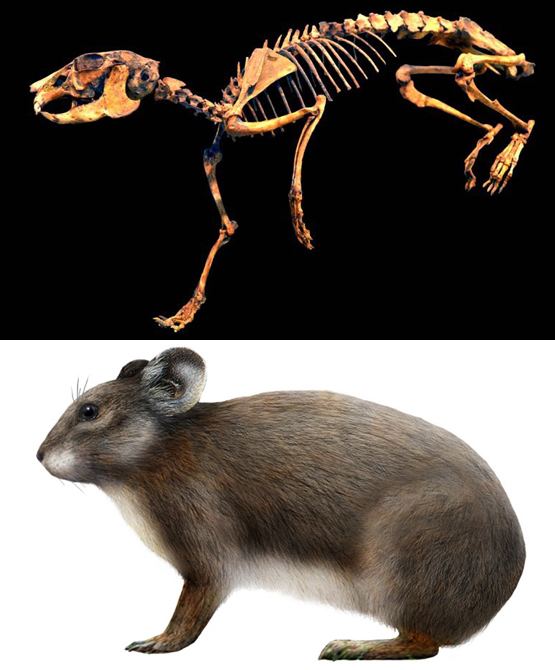This is a list of the mammal species recorded in Sardinia, Italy.
The following tags are used to highlight each species' conservation status as assessed by the IUCN.
Some species were assessed using an earlier set of criteria. Species assessed using this system have the following instead of near threatened and least concern categories:
Rodents make up the largest order of mammals, with over 40 percent of mammalian species. They have two incisors in the upper and lower jaw which grow continually and must be keep short by gnawing. Most rodents are small though the capybara can weigh up to 45 kg (100 lb).
Suborder: SciuromorphaFamily: Gliridae (dormice)Subfamily: GlirinaeGenus: GlisEdible dormouse, Glis glis LCSubfamily: LeithiinaeGenus: EliomysGarden dormouse, Eliomys quercinus NTSuborder: MyomorphaFamily: Cricetidae (hamsters and voles)Subfamily: CricetinaeGenus: TyrrhenicolaCorsican-Sardinian vole, Tyrrhenicola henseli EXFamily: Muridae (mice and rats)Subfamily: MurinaeGenus: ApodemusWood mouse, Apodemus sylvaticus LCGenus: MusHouse mouse, Mus musculus LCGenus: RattusBrown rat, Rattus norvegicus LCBlack rat, Rattus rattus LCThe lagomorphs comprise two families, Leporidae (hares and rabbits), and Ochotonidae (pikas). Though they can resemble rodents, and were classified as a superfamily in that order until the early 20th century, they have since been considered a separate order. They differ from rodents in a number of physical characteristics, such as having four incisors in the upper jaw rather than two.
Family: Leporidae (rabbits, hares)Genus: OryctolagusEuropean rabbit, Oryctolagus cuniculus LR/lcGenus: LepusCape hare, Lepus capensis LR/lcFamily: Prolagidae (European pikas)Genus: ProlagusSardinian pika, Prolagus sardus EXThe order Erinaceomorpha contains a single family, Erinaceidae, which comprise the hedgehogs and gymnures. The hedgehogs are easily recognised by their spines while gymnures look more like large rats.
Family: Erinaceidae (hedgehogs)Subfamily: ErinaceinaeGenus: ErinaceusEuropean hedgehog, Erinaceus europaeus LCThe "shrew-forms" are insectivorous mammals. The shrews and solenodons closely resemble mice while the moles are stout bodied burrowers.
Family: Soricidae (shrews)Subfamily: CrocidurinaeGenus: CrociduraNorth African white-toothed shrew, Crocidura ichnusae LCGenus: SuncusEtruscan shrew, Suncus etruscus LCSubfamily: SoricinaeGenus: NesiotitesSardinian shrew, Nesiotites similis EXThe bats' most distinguishing feature is that their forelimbs are developed as wings, making them the only mammals in the world naturally capable of flight. Bat species account for about 20% of all mammals.
Family: Miniopteridae (long-winged bats)Subfamily: MiniopterinaeGenus: MiniopterusFamily: Molossidae (free-tailed bats)Subfamily: MolossinaeGenus: TadaridaFamily: Rhinolophidae (horseshoe bats)Subfamily: RhinolophinaeGenus: RhinolophusFamily: Vespertilionidae (mouse-eared bats)Subfamily: MyotinaeGenus: MyotisSubfamily: VerpertilioninaeGenus: BarbastellaGenus: EptesicusGenus: HypsugoGenus: NyctalusGenus: PlecotusGenus: PipistrellusThe order Cetacea includes whales, dolphins and porpoises. They are the mammals most fully adapted to aquatic life with a spindle-shaped nearly hairless body, protected by a thick layer of blubber, and forelimbs and tail modified to provide propulsion underwater.
Suborder: MysticetiFamily: Balaenopteridae (rorquals)Genus: BalaenopteraCommon minke whale, Balaenoptera acutorostrata LCFin whale, Balaenoptera physalus ENSubfamily: MegapterinaeGenus: MegapteraHumpback whale Megaptera novaeangliae LCFamily: BalaenidaeGenus: EubalaenaNorth Atlantic right whale Eubalaena glacialis CR (possible)Suborder: OdontocetiFamily: Delphinidae (dolphins and pilot whales)Genus: GrampusRisso's dolphin, Grampus griseus LCGenus: GlobicephalaLong-finned pilot whale, Globicephala melas DDGenus: OrcinusKiller whale, Orcinus orca DDFamily: Physeteridae (sperm whales)Genus: PhyseterSperm whale, Physeter macrocephalus VUFamily: Ziphiidae (beaked whales)Genus: MesoplodonBlainville's beaked whale, Mesoplodon densirostris DDSowerby's beaked whale Mesoplodon bidens DDGenus: ZiphiusCuvier's beaked whale, Ziphius cavirostris LCThere are over 260 species of carnivorans, the majority of which feed primarily on meat. They have a characteristic skull shape and dentition.
Suborder: FeliformiaFamily: Felidae (cats)Genus: FelisAfrican wildcat, Felis lybica LCGenus: LynxSardinian lynx, Lynx lynx sardiniae EXSuborder: CaniformiaFamily: Canidae (dogs, foxes, wolves)Genus: CynotheriumSardinian dhole, Cynotherium sardous EXGenus: VulpesRed fox, Vulpes vulpes LCFamily: Mustelidae (weasels)Genus: MartesPine marten, Martes martes LCGenus: MustelaLeast weasel, Mustela nivalis LCFamily: Phocidae (earless seals)Genus: MonachusMediterranean monk seal Monachus monachus CR (possibly once became extinct on Sardinia and later repopulated in Gennargentu National Park)The even-toed ungulates are ungulates whose weight is borne about equally by the third and fourth toes, rather than mostly or entirely by the third as in perissodactyls. There are about 220 artiodactyl species, including many that are of great economic importance to humans.
Family: Suidae (pigs)Subfamily: SuinaeGenus: SusWild boar, Sus scrofa LCFamily: Bovidae (cattle, antelope, sheep, goats)Subfamily: CaprinaeGenus: OvisMouflon, Ovis aries orientalis VUFamily: Cervidae (deer)Subfamily: CervinaeGenus: CervusCorsican red deer, Cervus elaphus corsicanus NTGenus: DamaFallow deer, Dama dama LC
